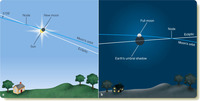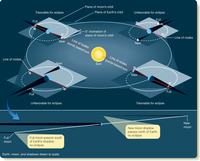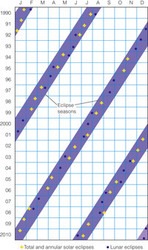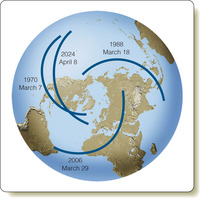|
|
A CHINESE STORY tells of two astronomers, Hsi and Ho, who were too drunk to predict the solar eclipse of October 22, 2137 BC. Or perhaps they failed to conduct the proper ceremonies to scare away the dragon that, according to Chinese tradition, was snacking on the sun’s disk. When the emperor recovered from the terror of the eclipse, he had the two astronomers beheaded.
Making exact eclipse predictions requires a computer and proper software, but some ancient astronomers could make educated guesses as to which full moons and which new moons might result in eclipses. There are three good reasons to reproduce their methods. First, it is an important chapter of the history of science. Second, it will illustrate how apparently complex phenomena can be analyzed in terms of cycles. Third, eclipse prediction will exercise your scientific imagination and help you visualize Earth, the moon, and the sun as objects moving through space.
Conditions for an EclipseYou can predict eclipses by thinking about the motion of the sun and moon in the sky. Imagine that you can look up into the sky from your home on Earth and see the sun moving along the ecliptic and the moon moving along its orbit. The orbit of the moon is tipped a bit over 5° to the plane of Earth’s orbit, so you see the moon follow a path tipped by that angle to the ecliptic. Each month, the moon crosses the ecliptic at two points called nodes. It crosses at one node going southward, and two weeks later it crosses at the other node going northward.
Eclipses can only occur when the sun is near one of the nodes of the moon’s orbit. Only then can the moon cross in front of the sun and produce a solar eclipse, as shown in Figure 3-13a. Most new moons pass too far north or too far south of the sun to cause an eclipse. A lunar eclipse doesn’t happen at every full moon because most full moons pass too far north or too far south of the ecliptic and miss Earth’s shadow. The moon can enter Earth’s shadow only when the shadow is near a node in the moon’s orbit, and that means the sun must be near the other node. You can see a lunar eclipse in Figure 3-13b.
So there are two conditions for an eclipse: The sun must be crossing a node, and the moon must be crossing either the same node (solar eclipse) or the other node (lunar eclipse). That means, of course, that solar eclipses can occur only when the moon is new, and lunar eclipses can occur only when the moon is full.
Now you know the ancient secret of predicting eclipses. An eclipse can occur only during a period called an eclipse season during which the sun is close to a node in the moon’s orbit. For solar eclipses, an eclipse season is about 32 days long. Any new moon during this period will produce a solar eclipse. For lunar eclipses, the eclipse season is a bit shorter, about 22 days. Any full moon in this period will encounter Earth’s shadow and be eclipsed.
This makes eclipse prediction easy. All you have to do is keep track of where the moon crosses the ecliptic (where the nodes of its orbit are). The eclipse seasons are danger intervals for eclipses. Any new moon that occurs within 16 days of the day the sun crosses a node will produce a solar eclipse. Any full moon that occurs within 11 days of the sun’s crossing a node will produce a lunar eclipse. This system works fairly well, and ancient astronomers such as the Maya may have used such a system. You could have been a very successful ancient Mayan astronomer with what you know about eclipse seasons, but you can do even better if you change your point of view.
The View from SpaceChange your point of view and imagine that you are looking at the orbits of Earth and the moon from a point far away in space. You would see the moon’s orbit as a small disk tipped at an angle to the larger disk of Earth’s orbit. As Earth orbits the sun, the moon’s orbit remains fixed in direction. The nodes of the moon’s orbit are the points where it passes through the plane of Earth’s orbit; an eclipse season occurs each time the line connecting these nodes, the line of nodes, points toward the sun. Look at Figure 3-14a and notice that the line of nodes does not point at the sun in the example at lower left, and no eclipses are possible. At lower right, the line of nodes points toward the sun, and the shadows produce eclipses.
The shadows of Earth and moon, seen from space, are very long and thin, as shown in the lower part of Figure 3-14. It is easy for them to miss their mark at new moon or full moon and fail to produce an eclipse. Only during an eclipse season, when the line of nodes points toward the sun, do the long, skinny shadows produce eclipses.
If you watched for years from your point of view in space, you would see the orbit of the moon precess like a hubcap spinning on the ground. This precession is caused mostly by the gravitational influence of the sun, and it makes the line of nodes rotate once every 18.6 years. People back on Earth see the nodes slipping westward along the ecliptic 19.4° per year. This means that, according to the calendar, the eclipse seasons begin about 19 days earlier every year (Figure 3-15). So the sun does not need a full year to go from a node all the way around the ecliptic and back to that same node. The node is slipping westward to meet the sun, and the sun will cross the node after only 346.6 days (an eclipse year). This means the eclipses gradually move around the year occurring about 19 days earlier each year. If you see an eclipse in late December one year, you will see eclipses in early December the next year, and so on.
The cyclic pattern of eclipses shown in Figure 3-15 should give you another clue as to how to predict eclipses. Eclipses follow a pattern, and if you were an ancient astronomer and understood the pattern, you could predict eclipses without ever knowing what the moon was or how an orbit works.
The Saros CycleAncient astronomers could predict eclipses in an approximate way using the eclipse seasons, but they could have been much more accurate if they had recognized that eclipses occur following certain patterns. The most important of these is the saros cycle (sometimes referred to simply as the saros). After one saros cycle of 18 years 111⁄3 days, the pattern of eclipses repeats. In fact, saros comes from a Greek word that means “repetition.”
The eclipses repeat because, after one saros cycle, the moon and the nodes of its orbit return to the same place with respect to the sun. One saros contains 6585.321 days, which is equal to 223 lunar months. Therefore, after one saros cycle, the moon is back to the same phase it had when the cycle began. But one saros is also equal to 19 eclipse years. After one saros cycle, the sun has returned to the same place it occupied with respect to the nodes of the moon’s orbit when the cycle began. If an eclipse occurs on a given day, then 18 years 111⁄3 days later the sun, the moon, and the nodes of the moon’s orbit return to nearly the same relationship, and the eclipse occurs all over again.
Although the eclipse repeats almost exactly, it is not visible from the same place on Earth. The saros cycle is one-third of a day longer than 18 years 11 days. When the eclipse happens again, Earth will have rotated one-third of a turn farther east, and the eclipse will occur one-third of the way westward around Earth (Figure 3-16). That means that after three saros cycles—a period of 54 years 1 month—the same eclipse occurs in the same part of Earth.
One of the most famous predictors of eclipses was the Greek philosopher Thales of Miletus (about 640–546 BC), who supposedly learned of the saros cycle from the Chaldeans, who had discovered it. No one knows which eclipse Thales predicted, but some scholars suspect the eclipse of May 28, 585 BC. In any case, the eclipse occurred at the height of a battle between the Lydians and the Medes, and the mysterious darkness in midafternoon so startled the two factions that they concluded a truce.
Although there are historical reasons to doubt that Thales actually predicted the eclipse, the important point is that he could have done it. If he had had records of past eclipses of the sun visible from the area, he could have discovered that they tended to recur with a period of 54 years 1 month (three saros cycles). Indeed, he could have predicted the eclipse without ever understanding what the sun and moon were or how they moved.
Why can’t two successive full moons be totally eclipsed?
Most people suppose that eclipses occur at random or in some pattern so complex you need a big computer to make predictions. You know the geometry is fairly simple, so you can build a simple argument to analyze this question. Remember that a lunar eclipse can happen only when the sun is near one node and the moon crosses Earth’s shadow at the other node.
Now you can apply what you know about the moon’s phases. An eclipse season for a total lunar eclipse is only 22 days long, but the moon takes 29.5 days to go from one full moon to the next. If one full moon is totally eclipsed, the next full moon 29.5 days later will occur long after the end of the eclipse season, and there can be no second eclipse.
Now use your knowledge of the cycles of the sun and moon to revise your argument. How can the sun be eclipsed by two successive new moons?
What Are We?
Special Effects
The moon is a companion in our daily lives, our history, and our mythology. It makes a dramatic sight as is moves through the sky, cycling through a sequence of phases that has repeated for billions of years. The moon has been humanity’s timekeeper. Moses, Jesus, and Muhammad saw the same moon that you see counting out the days, weeks, and months.
The moon is part of our human heritage. Have you enjoyed watching a beautiful moonrise? Have you skied by moonlight? Famous paintings, poems, plays, and music celebrate the beauty of the moon. Lunar and solar eclipses add a hint of mystery and spectacle. Earth would be a poorer planet if it had no moon.
We live on a planet with astonishing special effects. The phases of the moon and lunar and solar eclipses punctuate our lives and our history, giving rise to great legends and ancient superstitions. The moon plays out the grand mechanisms of our solar system on the wide screen of our sky and reminds us that we are riding a planet as it whirls through space.
Figure 3-13
Eclipses can occur only near the nodes of the moon’s orbit. (a) A solar eclipse occurs when the moon meets the sun near a node. (b) A lunar eclipse occurs when the sun and moon are near opposite nodes. Partial eclipses are shown here for clarity.
Figure 3-14
The moon’s orbit is tipped about 5° to Earth’s orbit. The nodes N and N’ are the points where the moon passes through the plane of Earth’s orbit. If the line of nodes does not point at the sun, the long narrow shadows miss, and there are no eclipses at new moon and full moon. At those parts of Earth’s orbit where the line of nodes points toward the sun, eclipses are possible at new moon and full moon.
Figure 3-15
A calendar of eclipse seasons. Each year the eclipse seasons begin about 19 days earlier. Any new moon or full moon that occurs during an eclipse season results in an eclipse. Only total and annular eclipses are shown here.
Figure 3-16
The saros cycle at work. The total solar eclipse of March 7, 1970, recurred after 18 years 111⁄3 days over the Pacific Ocean. After another interval of 18 years 111⁄3 days, the same eclipse was visible from Asia and Africa. After a similar interval, the eclipse will again be visible from the United States.




